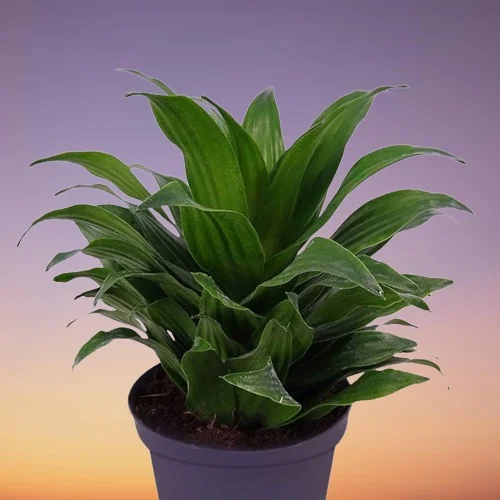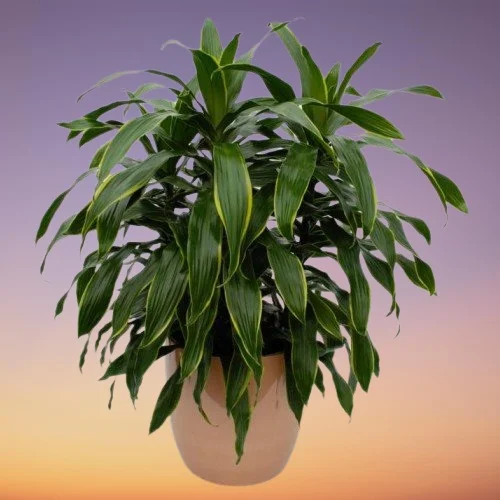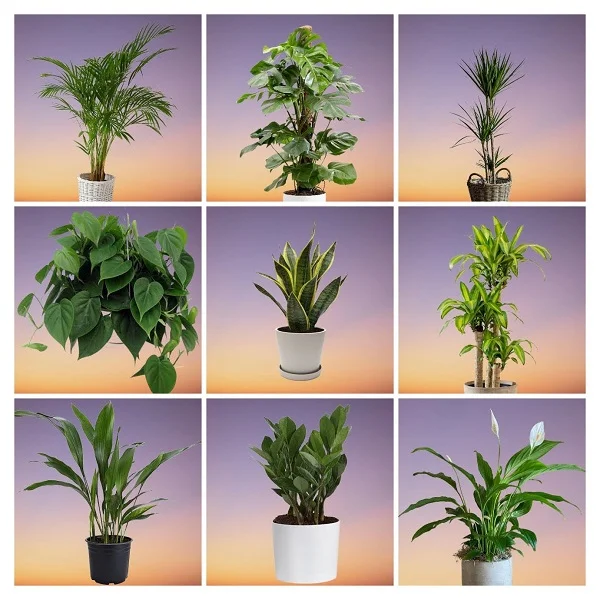Dracaena deremensis Care Indoors, Common Problems & their Solutions
Some links in this post may be affiliate links
Dracaena deremensis thrives in bright indirect light, average warmth, moderate humidity and consistently moist, rich, well-drained soil coupled with monthly feeding in the growing season.
Dracaena deremensis is one of the slow-growing Dracaena varieties and bears dark-green foliage with one or more longitudinal stripes in a different color.
As it grows, it sheds the lower leaves, leaving a bare stem with a cluster of leaves at the top. A new plant may drop a few leaves as it adjusts to its new home.
Unlike Song of India Plant (Dracaena reflexa) which is a small-sized plant, Dracaena deremensis, is a magnificent, large plant placing it among the best plants for the front porch or entrance for a great first impression.
Dracaena deremensis is also great as part of a mixed group, with the various leaf patterns complementing and overlapping one another.

Botanical name: Dracaena deremensis
Family: Asparagaceae
Subfamily: Nolinoideae
Origin
Dracaena deremensis is native Tropical Africa and Asia.
Size
Dracaena deremensis can grow to a height of 4 feet or more when mature and the leaves are about 1.5 feet long. Based on its size, its considered one of the best bold statement plants for any space.
Air Cleaning
According to the NASA Clean Air Study, Dracaena deremensis Janet Craig and Dracaena deremensis warneckii were found to be among the best air-purifying plants and get rid of xylene, toulene, benzene, formaldehyde and trichloethylene from indoor air.
Varieties
Some of the popular varieties of Dracaena deremensis are:
- Dracaena deremensis Janet Craig which is all green.
- Dracaena deremenis warneckii which bears white stripes close to the edge.
- Dracaena deremensis the basic variety, which has two broad white bands at the center.
- Dracaena deremensis Lemon Suprise has yellow edges.
- Dracaena deremensis Janet Craig Compacta has much smaller leaves about 8 inches long and is ideal for small spaces.
Is Dracaena deremensis poisonous?
Yes. Dracaena deremensis is toxic to both humans and pets as indicated by ASPCA. The leaves contain alkyds which if ingested they may cause vomiting and excessive salivation. Keep it away from the rech of children, cats, dogs and other pets.
Where to Buy
If you are looking to acquire Dracaena deremensis for your collection, you may obtain it online from Amazon (Link to Amazon) or from ( Link to Etsy).
How do you care for Dracaena deremensis indoors?
To care for Dracaena deremensis indoors, grow it in bright indirect light (filtered light), average warmth of 18-270C, moderate humidity of 50-55% and consistently moist, rich, well-drained soil coupled with monthly feeding in the growing season.
Dracaena deremensis care requires repotting only when the roots begin to grow through the drainage holes. Frequent pruning is necessary to keep the plant neat, to minimize pests and diseases and to rejuvenate growth. Keep reading for more on these growing conditions and how to achieve them.

Watering
How often do you water Dracaena deremensis?
Water Dracaena deremensis thoroughly in spring and summer while allowing the top 1-2 inches of soil to dry out between waterings. Keep the soil consistently moist but not soggy to prevent yellowing and leaf drop.
Decrease watering in fall and winter as growth is reduced to keep the soil slightly moist. Do not let the soil dry out completely to avoid wilting and drooping leaves.
Ensure that pot has a drainage hole and the soil is free-draining to avoid getting soggy soil which can result in root-rot and death of the plant.
Use room temperature water that is free of chlorine, flourides and other chemicals to prevent brown leaf tips.
Light Requirements
Can I grow Dracaena deremensis in low light?
Dracaena deremensis grows best in bright indirect light (dappled light). Place it near a large, brightly-lit window but away from direct sunlight to prevent scorching of the leaves; unsightly brown spots on the leaves.
It can tolerate some shade but the the leaves will be much narrower. Where the natural light is not adequate, you may use a grow light to supplement it.
Regularly rotate the pot to ensure that the plant receives light on all sides for a balanced growth and prevent leggy growth.
Temperature and Humidity
Dracaena deremensis flourishes in an average warmth of 18-270C with a minumum of 150C. Keep it away from drafts coming from windy doors, hot air vents, stoves, AC units and others to avoid temperature flactuations.
Dracaena deremensis requires a moderate humidity of 50-55%. However, too dry air may result in brown leaf tips and edges. To increase humidity, set the pot on a wet pebble tray, use a humidifier or group the plants together. Maintain good air flow to minimize fungal diseases.
Fertilizer
How often should I fertilize my Dracaena deremensis?
Feed your Dracaena deremensis with a balanced, water-soluble fertilizer monthly in spring and summer to encourage a lush growth. Do not feed in fall and winter as growth is minimal and feeding at this time can lead to fertilizer burn.
Flush out accumulated salts from the soil every 1-2 months by running a stream of water through the soil until the water comes out through the drainage hole. Allow it to run for a few minutes and repeat several times.
Potting Soil
The best soil for Dracaena deremensis is a rich, well-draining soil to prevent waterlogging while providing the required nutrients. A blend of 2 parts potting soil, 1 part perlite, and 1 part orchid bark is ideal for this plant.
Repotting
Repot your Dracaena deremensis at the beginning of the growing season when roots begin to grow through the drainage hole as it prefers to be slightly pot-bound.
Use a pot 1 size larger that has a drainage hole to prevent the soil from getting soggy to avoid root-rot; never allow the roots to sit in soggy soil. Check out these pots with drainage holes on Amazon.
Pruning & Maintenance
Pruning Dracaena deremensis involves removal of dead and yellow leaves to maintain the plant neat and tidy as well as discourage pests and diseases.
Prune thin or bare stemmed plants during the growing season by cutting off the top crown of leaves along the stem. New leaves will sprout just below the cut. The crown of leaves can be used to propagate a new plant.
Clean the leaves by damp-wiping with a soft cloth to get rid of dust and also discourage pest infestations.
Dracaena deremensis Propagation
Dracaena deremensis is propagated at the beginning of the growing season (spring) by air layering, from the top crown of leaves or from stem cuttings which can be rooted either in water or in soil.
Learn how to propagate Dracaena deremensis by 4 propagation methods.

Dracaena deremensis Common Problems & Fixes
Dracaena deremensis common problems are yellow leaves, brown leaves, brown leaf tips, dying plant, pests and diseases among others. Keep reading for more on these problems and their solutions.
Yellow leaves
Some of the causes of yellow leaves on your Dracaena deremensis are overwatering, soggy soil, temperature stress, and nutrient deficiency.
How to fix it
Overwatering: Do not water on a schedule. Water only when the top 1-2 inches of soil dry.
Soggy soil: Use a well-draining potting soil and a pot that has a drainage hole.
Temperature stress: Keep the plant away from drafts coming from hot surfaces, hot air vents, AC units, windy doors among others.
Nutrient deficiency: Apply a balanced, water-soluble fertilizer every 4 weeks in spring and summer.
Check out these 14 reasons why Dracaena leaves are yellowing and their remedies.
Brown leaves
Why are my Dracaena deremensis leaves turning brown?
The main causes of brown leaves on your Dracaena deremensis are inconsistent watering, soggy soil, temperature stress, direct sunlight, and aging.
How to fix it
Inconsistent water: Water when the top 1-2 inches of soil dry. Never allow the soil to dry out completely.
Soggy soil: Use a pot that has a drainage hole and a well-draining potting soil.
Temperatute stress: Protect the plant from drafts emanating from AC units, heat sources, windy doors among others.
Direct sunlight: Keep the plant away from direct sunlight or use a light curtain to filter the sunshine.
Aging: This is a natural process; as the plant matures the lower leaves turn brown and die.
Brown leaf tips
Brown leaf tips on Dracaena deremensis are caused by dry air, underwatering, salts buidup, and cold drafts.
How to fix it
Dry air: To elevate humidity, set the pot on a wet pebble tray, use a humidifier or grow the plant in a well-lit bathroom and other humid areas.
Underwatering: Maintain the soil consistently moist in spring and summer and slightly moist in fall and winter but do not allow the soil to dry out completely.
Salts buildup: Use rain water or filtered water. Flush out accumulated salts from the soil regularly by running a steady stream of water through the soil until it drips through the draiange hole.
Cold drafts: Place the plant away from cold drafts like windy doors, drafty windows, AC units among others.
Plant dying
Dracaena deremensis is dying due to root-rot, cold drafts, and salts buildup.
How to fix it
Root-rot: The disease is promoted by soggy soil. It is characterized by yellowing and wilting of the leaves which is rapidly followed by browning and plant collapse.
- Carefully slip the plant out of its pot and inspect the roots.
- Trim the brown-black, mushy roots and treat the healthy roots with a copper-based fungicidal solution. Ensure to follow the instructions on the label.
- Disinfect the pot with the fungicidal solution or use a fresh pot to repot the plant in fresh, well-draining soil.
- Do not water the plant immediately and keep it dry for 5-7 days before you resume watering.
- Use a pot with a drainage hole and well-draining soil to avoid getting soggy soil.
- Lessen watering in fall and winter as growth is slowed at this time; keep the soil slightly moist.
Cold drafts: Keep the plant away from cold drafts to maintain temperatures of 18-270C
Salts buildup: Regularly flush out accumulated salts from the soil by running a stream of water through the soil until the water comes out through the drainage hole.
Pests
What pests attack Dracaena deremensis?
Common pests on Dracaena deremensis are mealybugs, scale insects and spidermites.
How to fix it
- Isolate the affected plant to prevent spread to the other plants and treat it with neem oil or insecticidal soap as per the manufacturers recommendations.
- Regularly check underneath the leaves for these pests and carry out timely control measures.
- Keep the plant properly pruned and raise humidity to discourage pest infestation.
Conclusion
Dracaena deremensis is a resilient, air-purifying, low-maintenance plant that brings life and elegance to any space. Whether you are a seasoned plant parent or just starting your indoor garden, mastering Dracaena deremensis indoor care is your ticket to lush, vibrant greenery. With just a little know-how and consistency, this plant will reward you with beauty and vitality for years to come.
You liked it? Share on social media.
Related Content
Amazon Associates Disclosure
Homeplantsguide.com is a participant in the Amazon Services LLC Associates Program, an affiliate advertising program designed to provide a means for sites to earn advertising fees by advertising and linking to amazon.com.





